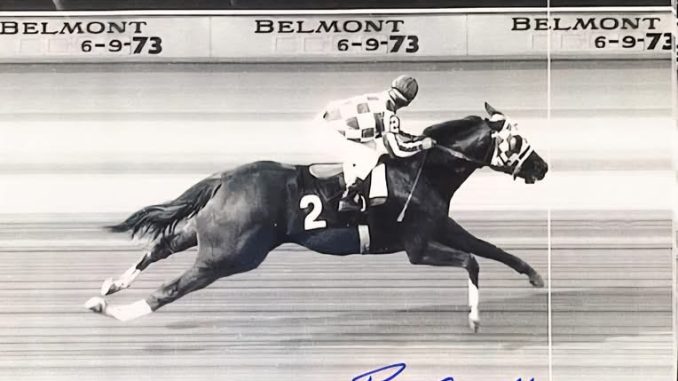
Belmont Park, June 9, 1973 — On a radiant early summer afternoon, more than 69,000 spectators packed the grandstands at Belmont Park, their excitement palpable. They came to witness a contest for the ages: could Secretariat, the striking chestnut colt with a blazing reputation, capture the elusive Triple Crown? What unfolded on the sprawling 1½-mile dirt track was not merely a race, but an event that would etch Secretariat’s name into the pantheon of sports legends forever.
The tension was thick as the gates flew open. Secretariat exploded out of the starting gate with a burst of energy likened to a rocket’s launch. Close behind, his fiercest rival Sham matched his pace, determined to challenge the powerful favorite. But from the outset, the tempo was blistering — far beyond the usual cautious beginnings of a demanding distance race.
Seasoned onlookers and bettors murmured anxiously. “He’s going too fast,” some whispered, wary that such a punishing pace might break the colt before the finish. But Secretariat was impervious. This was his moment — he was running not just to win, but to redefine greatness.
By the half-mile marker, Sham’s bold challenge began to falter. The strain of chasing Secretariat’s relentless speed took its toll, and the challenger’s pace slowed, his courageous attempt to stay alongside the champion crumbling. Meanwhile, Secretariat surged ahead, widening the gap between himself and the rest of the field.
Lengths quickly stretched into double digits — five, then ten, then twenty — each thunderous stride propelling Secretariat further into an extraordinary realm of dominance. The crowd was electrified, caught between disbelief and awe, witnessing a performance unlike anything the sport had ever seen.
As they entered the final stretch, jockey Ron Turcotte glanced back over his shoulder — a glance that would become immortalized in racing history. There was no one there. No challenger, no threat, just empty track behind the blazing chestnut. Secretariat was alone, a fiery red blur accelerating with every stride, moving faster than anyone thought possible.
The stadium erupted as track announcer Chic Anderson’s voice reverberated through the loudspeakers: “Secretariat is widening now! He is moving like a tremendous machine!” The words perfectly captured the sheer force and grace of the moment, as the colt thundered toward the finish line.
When Secretariat crossed the wire, he did so by an astonishing 31 lengths — an unfathomable margin that stunned all who witnessed it. The time? An eye-popping 2 minutes and 24 seconds flat for 1½ miles — a world record and track record that has stood unchallenged for decades.
The atmosphere exploded. Cheers turned into roars. Fans, some weeping tears of joy, embraced strangers around them. The magnitude of what they had just seen settled over Belmont Park like a tangible wave of reverence. This was not just a victory; it was an era-defining moment, a transcendent display of speed, stamina, and spirit.
Secretariat’s Belmont Stakes run remains one of the greatest individual athletic performances ever recorded, transcending horse racing to become a symbol of pure excellence. It was a masterclass in power and poise — a demonstration of a horse not merely competing, but commanding the sport with majestic authority.
For jockey Ron Turcotte, the race was as unforgettable as the crowd’s frenzy. His quick glance back, capturing the vast emptiness trailing behind Secretariat, perfectly encapsulated the enormity of the achievement. That split-second image became an enduring symbol — a snapshot of a champion so far ahead, he had left history behind.
The legacy of Secretariat’s 1973 Belmont Stakes performance lives on in the hearts of racing fans and sports enthusiasts worldwide. It’s a story retold not just for the statistics or the records, but for the feeling it evokes: a testament to what it means to be truly great.
On that day, Secretariat didn’t simply win — he was crowned a legend. And his thunderous run at Belmont Park forever changed the landscape of horse racing, setting a standard of excellence that inspires awe to this day.
Would you like me to help you add quotes from key figures, or maybe provide some historical context on Secretariat’s Triple Crown run?
Leave a Reply